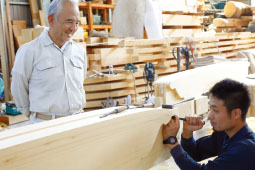Home > Highlighting JAPAN > Highlighting Japan November 2018 > Living In Tune with Nature: Japan's Connection to Wood
Highlighting JAPAN


A Life Dedicated to Wood and Community
Mitsuo Ogawa is a renowned master carpenter who has been the head craftsman on projects for numerous shrines and temples. He is the sole apprentice of Tsunekazu Nishioka, the descendant of master carpenters who oversaw the construction of Nara’s Horyuji Temple. Ogawa shares his thoughts about the high degree of technical skill and craftsmanship that miyadaiku—Japan’s time-honored shrine and temple carpenters—must possess.
One definitive point of difference between the construction of shrines and temples and normal housing is the use of massive trees that sometimes reach dozens of meters in height. “You can whittle down smaller trees, but with big trees any odd pattern in the grain will be readily apparent. Being a miyadaiku (shrine carpenter) is all about drawing out those odd patterns and working with them,” master carpenter Mitsuo Ogawa points out. “But the grain in trees only goes in one direction, whereas odd patterns in people are much more complicated.”
Ogawa, who has over fifty years of shrine carpentry experience, instructs the next generation of miyadaiku at his training school, Ikaruga Kosha, and so has spent many years dealing with both wood and people.
Originally from Tochigi Prefecture, Ogawa decided to become a shrine carpenter during a high school trip as he stared up at the five-story pagoda of Nara’s Horyuji Temple. After learning that the pagoda had been standing for thirteen centuries, he was awed by how trees so huge were hauled up that long ago, and became obsessed with the idea of creating something like that himself.
However, when he told his father—a bank employee—about his ambitions, the latter was firmly opposed, saying: “It’s like swimming upstream, it’s a hard life, and you’ll never be able to relax and have time to yourself.” Ogawa ran away from home, and his parents disinherited him. He sought out Tsunekazu Nishioka, the descendant of master craftsmen who oversaw construction at Horyuji Temple. Nishioka rejected him at first, but finally accepted Ogawa as an apprentice after he went through training in the construction of household Buddhist altars in Nagano.
As a live-in apprentice in the Nishioka household, Ogawa spent his days studying master craftsmanship and woodworking, and his nights sharpening the metal tools they worked with. After learning how to create blueprints and design plans, he worked as the junior craftsman on the reconstruction of Horinji Temple’s three-story pagoda and Yakushiji Temple’s West Pagoda and main temple. “I was with master Nishioka for twenty-seven years, but he never taught me anything directly. Only once, about three months after I’d become his pupil, he told me, ‘For something like this, you shave it down,’ and shaved it himself, handing me one practically transparent wood shaving. I placed it on my windowpane, and whether I was awake or asleep I thought about wood and temples constantly, and kept working on my skills.”
Ogawa firmly believes that technique can’t be taught in books, only learned through practical experience, and that by living with other carpenters and sharing meals with them your way of thinking and behavior will become that of a carpenter. Even after founding Ikaruga Kosha and becoming a master craftsman with apprentices of his own, he still has trainees live and eat with him in his home to pass on his techniques.
“Through communal living, you come to understand and sympathize with those you’re living with,” he says. “If those feelings aren’t there between each person, it’s impossible to work together on a large-scale temple reconstruction project.” He’s trained more than a hundred carpenters, working with them on shrine and temple building projects for a variety of sects and in a multitude of styles all over Japan.
Becoming a master craftsman isn’t possible unless you deeply understand both wood and people. Thirteen centuries ago when there were no sawmills and people could only cut trees down and work with them as they were, how did the ancients build Horyuji Temple?
“Horyuji Temple is made of hinoki cypress,” Ogawa states. “If it were cedar, it would have lasted about nine hundred years. But hinoki cuts clean, and is at its strongest two centuries after being cut down. That’s why Horyuji has stood for 1300 years. I believe there was a master craftsman back then who knew the properties of hinoki and had the intelligence and leadership abilities to use a huge number of people to carry the trees up.”
Continued deforestation means they are running out of the large trees suitable for shrine and temple reconstruction. But Ogawa, often called an artisan, states quietly and with the confidence of experience that “for the next generation to succeed, we can start growing both the wood and the people right now.”
© 2009 Cabinet Office, Government of Japan







